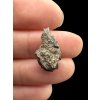Meteorite Nantan 1,7g – Guangxi, China
Type: iron, IAB
Locality: Guangxi Province, China
Weight: 1,7g
Dimensions: 1,6 x 0,9 x 0,3 cm
Year found: 1958
Total known weight: 9,5 tonnes
Surface treatment: none – raw
Packing: Plastic box (5,8 x 3,8 x 1,6 cm)
| Category: | Nantan |
|---|---|
| By name: | Nantan |
| ? Type: | Iron |
| ? Surface treatment: | Natural (raw) |
| Packaging: | In box |
Nantan Meteorite – Historical Iron Meteorite from China
The Nantan meteorite is a significant iron meteorite, whose fall was likely recorded in the year 1516 in the Chinese province of Guangxi. Despite this historical sighting, it remained unnoticed for a long time and was officially discovered only in 1958. It belongs to the group of iron meteorites of type IAB, which means it contains a high proportion of iron, nickel and other trace elements. Due to the high iron content, Nantan meteorites are prone to corrosion, which makes their long-term preservation difficult.
History and Discovery
Although it fell already in the 16th century, it was not collected until the 20th century. The reasons were local superstitions and technical limitations – local people considered meteorites sacred and often left them untouched.
Size and Fragment Distribution
During the fall, the meteorite broke into thousands of fragments scattered over an area about 28 kilometers long. The size of the individual pieces ranged from tiny particles weighing 10 grams to massive blocks weighing up to 2,000 kilograms. The total weight of the recovered fragments is estimated at 9.5 tons.







